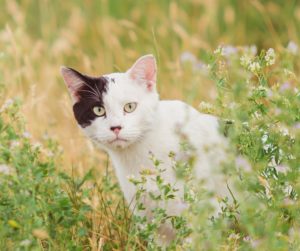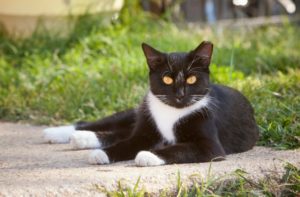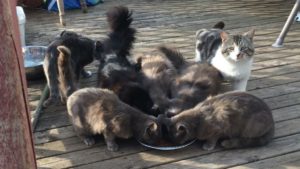TNR is a small name with a big impact. Since 2016, the SPCA’s TNR – Trap Neuter Return – Program has been working to make the world a better place for feral cats and neighbourhoods.

What is a feral cat? Well, pets and stray cats are socialized to people whereas feral cats have had little or no interaction with humans. What would cause your cuddly pet cat to purr would cause a feral cat significant stress.
Did you know that spaying/neutering one feral cat can prevent as many as 180 kittens from being born?! Here’s how… Cats can begin to breed at just six months old. On average, female cats can produce 1.5 litters per year, each with an average of 4 kittens. It doesn’t take long for numbers to rise exponentially! That is why TNR is so important.

Through TNR, feral cats are humanely trapped, spayed/neutered and ear-tipped1 in the SPCA’s mobile surgical clinic. After they recover, they are returned to their home – their colony – where they will be much happier. Their lives are improved AND they won’t have any unwanted or accidental litters! Kittens, along with any friendly cats are taken to SPCA shelters or placed in foster homes where they will be cared for until they’re ready to find a loving home.
TNR helps feral cats live healthier, longer and more peaceful lives. Here’s how…. TNR relieves cats of the constant stress of mating and pregnancy. Spaying/neutering also virtually eliminates the chance of cats developing mammary or testicular tumors. Their overall health improves too, as spaying/neutering helps them gain weight and enhances their coat condition. Mating behaviors stop – including roaming, yowling, spraying and fighting. This benefits the cats’ safety and makes them less likely to suffer injuries.

TNR also makes feral cats better neighbours! A neutered male cat has a smaller ‘home’ area that he roams, since he doesn’t have the same drive to look for a mate. That means less fighting and spraying as his hormones decrease. Colonies become quieter as behaviours like yowling or fighting are drastically improved.
Heather Woodin, Nova Scotia SPCA Director of Programs & Administration said “We are so grateful for the amazing volunteers, staff, and rescue groups who have spent their evenings and weekends dedicated to TNR since the program began. We are also grateful for kind-hearted citizens who care for feral cat colonies in their neighbourhoods. Because of their dedication, less kittens are born into a hard life outside and feral cats can live happier, healthier lives no longer in constant distress while colonies decline in population over time.”

Numbers associated with the TNR Program clearly show its success. Heather shared “During the first six months of the program’s operation in 2016, an amazing 780 feral cats were spayed/neutered. In 2018, 978 cats were fixed and 2023 saw 274 cats fixed. In this case, declining numbers are a fabulous achievement! And although numbers are declining, each and every surgery performed on a feral cat is valuable to that cat and to the community.”
The SPCA needs to stay on top of the feral cat situation so the population doesn’t get out of control again. To do that, they need YOUR help. Please report any colonies in your neighbourhood before you have kittens at your doorstep! TNR services are FREE and the SPCA is there for advice and support. You can contact the SPCA directly by calling 902-468-7877, emailing catcolony@spcans.ca or filling out a simple online form here. The more people report, the quicker the SPCA can respond and the more cats they can help.
Here are some other ways to help feral cats:
- Food, food, food. Caregivers or concerned citizens who are interested in providing food and managing cat colonies are encouraged to contact the SPCA at catcolony@spcans.ca for advice and support.
- Provide shelter options during cold weather. A simple and inexpensive way is to renovate a plastic storage bin – like a Rubbermaid container – and fill it with straw for insulation. SPCA tip: Always make sure to use straw, not hay or blankets, for outdoor feral cat shelters. Hay and blankets soak up moisture making it cold and uncomfortable whereas straw actually repels moisture.
- Set an example and spay it forward! Beginning way back in 1979 and continuing for the next three decades, Bob Barker, host of The Price is Right, finished each episode with his mantra message: “This is Bob Barker reminding you to help control the pet population – have your pets spayed or neutered.” Spaying/neutering is one of the most important things you can do for your pet, your family and your community. Check out spcavet.ca to book an appointment!
1 So… what the heck is an ear tip? Ear-tipping on the cat’s left ear is an effective and universally accepted method to identify a spayed/neutered feral cat. It is relatively painless to the cat and is done while they are already under anesthesia for their surgery. Because it can be difficult to get close to a feral cat, this identification makes it is easy to spot at a distance and prevents unnecessary second trapping and surgery.
